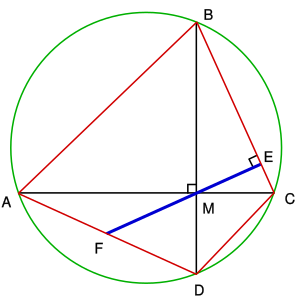Brahmagupta's theorem
The Brahmagupta theorem is a statement in Euclidean geometry on track conditions in certain tendons squares.
"If the diagonals are perpendicular to each other in a chordal quadrilateral , then the perpendicular divides the opposite side into 2 equal sections through the diagonal intersection on one side."
The statement is named after the Indian mathematician and astronomer Brahmagupta (598–668).
literature
- HSM Coxeter , SL Greitzer: Timeless geometry . Klett, Stuttgart, 1983
Web links
- Eric W. Weisstein : Brahmagupta's theorem . In: MathWorld (English).
- Brahmagupta's sentence at cut-the-knot


